For a spacecraft designed to conduct unique studies of the Sun, Solar Orbiter is also making a name for itself exploring comets. For several days centered on 1200-1300 UT on December 17, 2021, the spacecraft found itself flying through the tail of Comet C/2021 A1 Leonard.
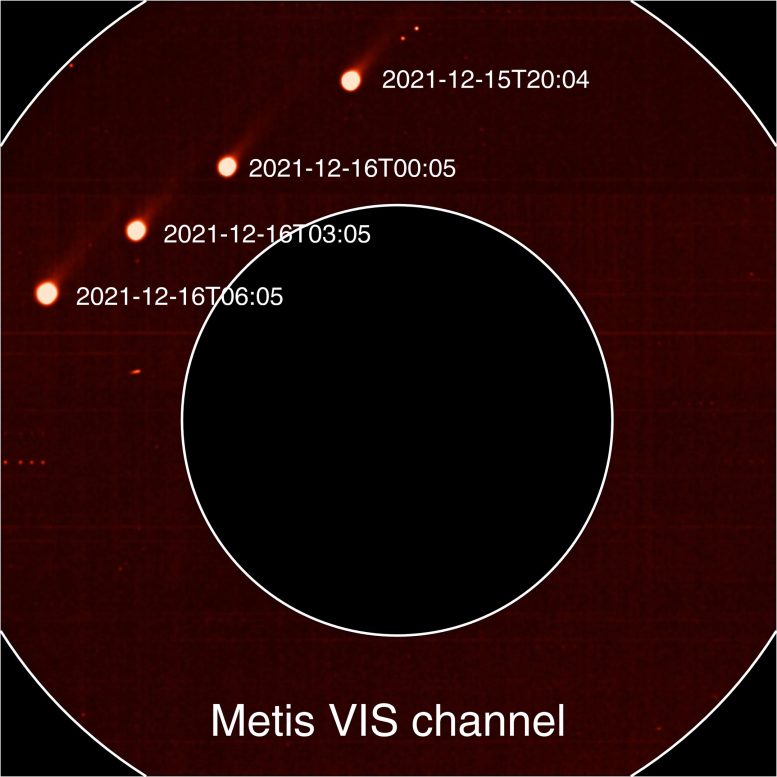
A composite of Comet Leonard images captured December 15-16, 2021, in visible light by the Metis instrument onboard the ESA/NASA Solar Orbiter spacecraft. The comet transited across the field of view with its dust and ion tails pointing towards the instrument. Credit: ESA/Solar Orbiter/Metis Team
The encounter captured information about the particles and magnetic field present in the tail of the comet. This will allow astronomers to study the way the comet interacts with the solar wind, a variable wind of particles and magnetic field that emanate from the Sun and sweep through the solar system.
The crossing had been predicted by Samuel Grant, a post graduate student at University College London’s Mullard Space Science Laboratory. He adapted an existing computer program that compared spacecraft orbits with comet orbits to include the effects of the solar wind and its ability to shape a comet’s tail.
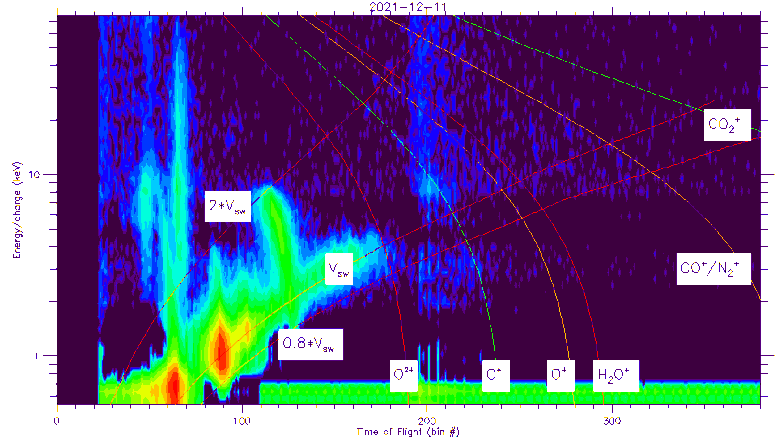
This plot series represents data collected by the Solar Wind Analyser’s Heavy Ion Sensor as the ESA/NASA Solar Orbiter spacecraft passed through Comet Leonard’s tail in December 2021. The data cover December 11-20, with the first and ta crossing, respectively, marked by an absence of singly ionized ions. During the tail crossing the instrument detected particles that are attributable to the comet rather than the solar wind, for example ions of oxygen, carbon, and molecular nitrogen, and molecules of carbon monoxide, carbon dioxide, and water. (Ions are atoms or molecules that have been stripped of one or more electron and now carry a net positive electrical charge.) Credit: ESA/Solar Orbiter/SWA team
“I ran it with Comet Leonard and Solar Orbiter with a few guesses for the speed of the solar wind. And that’s when I saw that even for quite a wide range of solar wind speeds it seemed like there would be a crossing,” he says.
At the time of the crossing, Solar Orbiter was relatively close to the Earth having passed by on November 27, 2021, for a gravity assist maneuver that marked the beginning of the mission’s science phase, and placed the spacecraft on cou approach to the Sun. The comet’s nucleus was 44.5 million kilometers away, near to the planet Venus, but its giant tail stretched across space to Earth’s orbit and beyond.
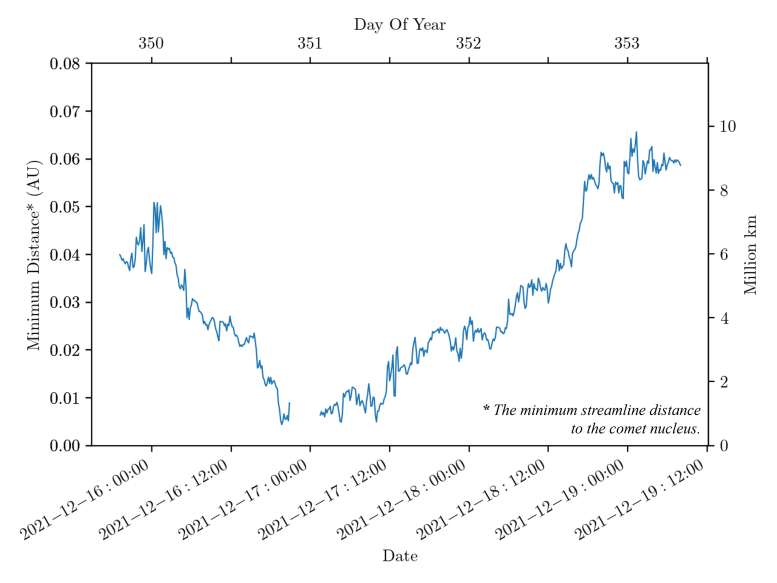
This data plot uses solar wind speed and direction data from the Solar Wind Analyser’s proton and alpha sensor (SWA-PAS) to estimate how close the ESA/NASA Solar Orbiter spacecraft approached to the center of Comet C/2021 A1 Leonard’s ion 2021. The plot records how close each packet of solar wind detected by SWA-PAS is thought to have got to the comet’s nucleus during its journey from the Sun to the spacecraft. The left axis gives the scale in astronomical units (au), where 1 au is the distance from the Sun to the Earth, and the same distance is shown in kilometers on the right axis.
Changes in the solar wind flow speed and direction are responsible for the variations in the plotted distance. There are short data acquisition gaps on December 15 and 17. Credit: ESA/Solar Orbiter/SWA team & S. Grant (UCL)
So far, the best detection of the comet’s tail from Solar Orbiter has come from the Solar Wind Analyser (SWA) instrument suite. Its Heavy Ion Sensor (HIS) clearly measured atoms, ions, and even molecules that are attributable to the comet rather than the solar wind.
Ions are atoms or molecules that have been stripped of one or more electron and now carry a net positive electrical charge. SWA-HIS detected ions of oxygen, carbon, molecular nitrogen, and molecules of carbon monoxide, carbon dioxide and possibly water. “Because of their small charge, these ions are all clearly of cometary origin,” says Stefano Livi, Lead Investigator of SWA-HIS from Southwest Research Institute, Texas.
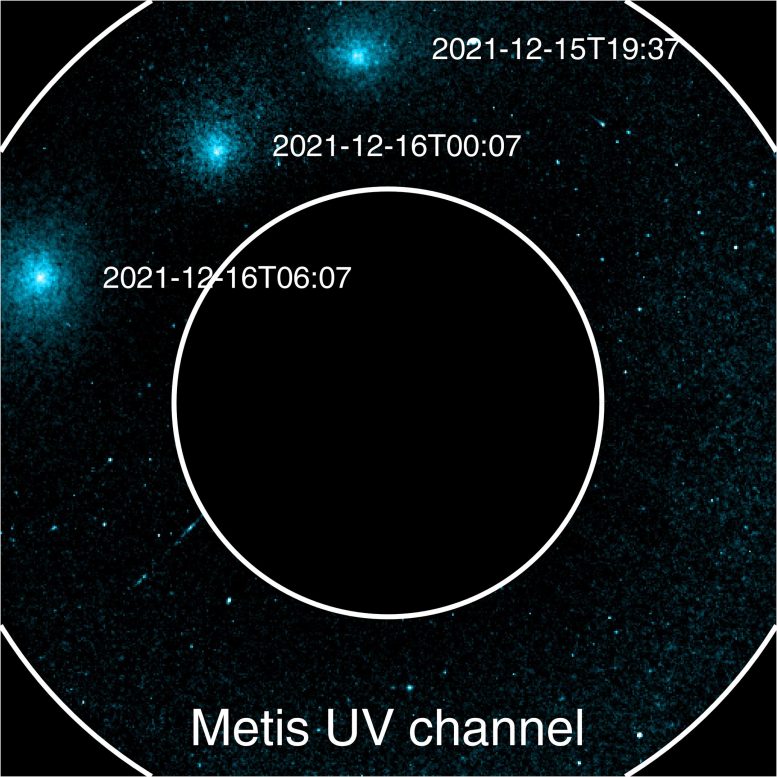
A composite of Comet Leonard images captured December 15-16, 2021, in ultraviolet light by the Metis instrument onboard the ESA/NASA Solar Orbiter spacecraft. The comet transited across the field of view with its dust and ion tails pointing towards the instrument. Credit: ESA/Solar Orbiter/Metis Team
As a comet moves through space, it tends to drape the Sun’s magnetic field around it. This magnetic field is being carried by the solar wind, and the draping creates discontinuities where the polarity of the magnetic field changes sharply from north to south and vice versa.
The magnetometer instrument (MAG) data does indeed suggest the presence of such draped magnetic field structures but there is more analysis to be done to be absolutely sure. “We are in the process of investigating some smaller scale magnetic perturbations seen in our data and combining them with measurements from Solar Orbiter’s particle sensors to understand their possible cometary origin,” says Lorenzo Matteini, a co-investigator on MAG from Imperial 。
In addition to the particle data, Solar Orbiter also acquired images.
-
A composite of Comet Leonard images captured December 15-16, 2021, in visible light by the Metis instrument onboard the ESA/NASA Solar Orbiter spacecraft. The comet transited across the field of view with its dust and ion tails pointing towards the instrument. Credit: ESA/Solar Orbiter/Metis Team
-
NASA’s Parker Solar Probe was almost on the opposite side of the Sun from the ESA/NASA Solar Orbiter spacecraft when its WIPSR instrument recorded images of Comet Leonard on December 7, 2021. From Parker Solar Probe’s viewpoint the comet appeared we地球。 Credit: NASA/USNRL/G.Stenborg/K.Battams
-
NASA’s Parker Solar Probe was almost on the opposite side of the Sun from the ESA/NASA Solar Orbiter spacecraft when its WIPSR instrument recorded images of Comet Leonard on December 7, 2021. From Parker Solar Probe’s viewpoint the comet appeared we地球。 Credit: NASA/USNRL/G.Stenborg/K.Battams
Metis is Solar Orbiter’s multi-wavelength coronagraph. It can perform ultraviolet observations that see the Lyman alpha emission given out by hydrogen, and it can measure the polarisation of visible light. During December 15 and 16, it captured the distant head of the comet simultaneously in both visible and ultraviolet light. These images are now being analysed by the instrument team. “The visible light images can hint at the rate at which the comet is ejecting dust, while the ultraviolet images can give the water production rate,” says Alain Corso, a Metis co-investigator at the CNR-Istituto di Fotonica e Nanotecnologie, Padova 、イタリア。
The Solar Orbiter Heliospheric Imager (SoloHI) also captured data. These images show large parts of the comet’s ion tail taken while the spacecraft itself was inside the tail. As the image sequence progresses, changes in the tail can be seen in response to variations in the solar wind speed and direction.
And it was not just Solar Orbiter that was watching the crossing. The ESA/NASA SOHO mission and NASA’s STEREO-A and Parker Solar Probe spacecraft were observing from afar. This means that not only do astronomers now have data from inside the tail, they also have contextual images from these other spacecraft (see images above).
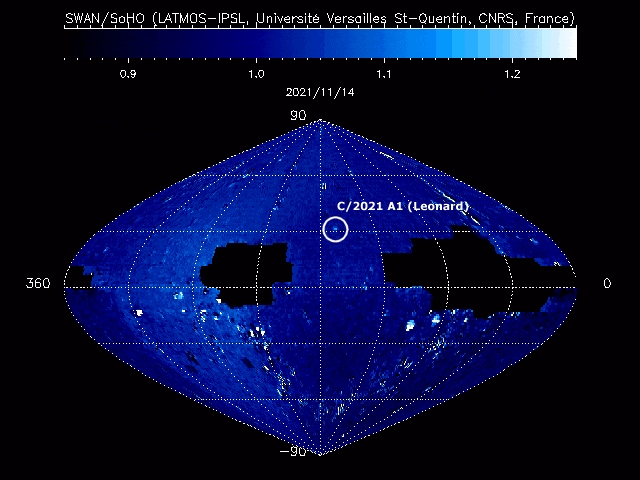
The SOHO spacecraft detected Comet Leonard in its Solar Wind Anisotropies (SWAN) instrument in Lyman-alpha. SWAN doesn’t look directly at the Sun, it rather maps the whole sky in ultraviolet light, and sees interstellar hydrogen that interacts with the solar wind. The maps can be used to reveal bright points in ultraviolet light indicating the presence of a comet, for example, as is the case here. Credit:SOHO(ESA&NASA); W. Boonplod
Comet tail crossings are relatively rare events. Of those that have been detected, most have been noticed only after the event. The ESA/NASA Ulysses mission encountered three comet ion tails, including that of C/1996 B2 Hyakutake in May 1996, and C/2006 P1 McNaught in early 2007. Solar Orbiter itself crossed the May at 5 and June 2020, shortly after launching.
Whereas the early crossings were a surprise, both of Solar Orbiter’s encounters were predicted in advance thanks to the computer code developed by Geraint Jones, University College London Mullard Space Science Laboratory, and extended by Samuel.
“The big advantage is that for basically no effort on the spacecraft’s part, you get to sample a comet at a massive distance. That’s pretty exciting,” says Samuel, who is now looking at archive data from other spacecraft looking for comet tail crossings that have so far gone unnoticed.
The work also helps build experience for ESA’s Comet Interceptor mission, for which Geraint is the Science Team Lead. The mission will visit an as-yet undiscovered comet, making a flyby of the target with three spacecraft to create a 3D profile of a ‘dynamically new’ object that contains unprocessed material surviving from the dawn of the Solar System.
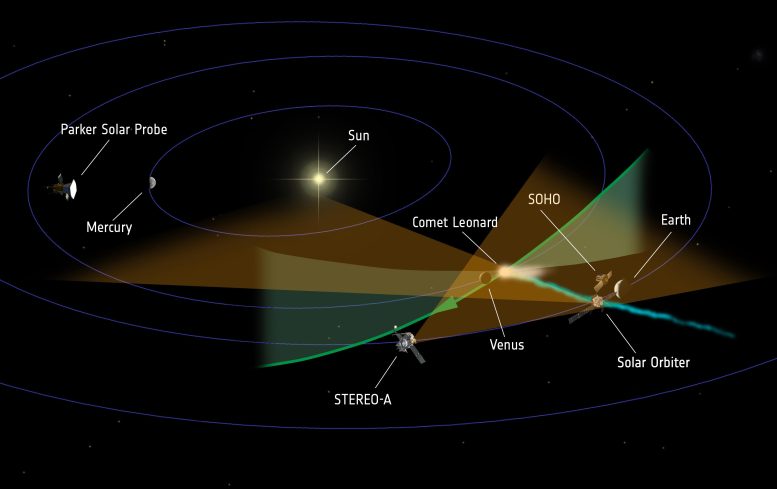
The ESA/NASA Solar Orbiter spacecraft flew through the tail of Comet C/2021 A1 Leonard in December 2021, collecting images and in-situ solar wind and particle data. At the same time, SOHO (ESA/NASA), Parker Solar Probe (NASA) and STEREO-A (NASA) were also watching the comet’s evolution from other angles. The graphic shows the approximate relative positions of the planets, comet, and spacecraft on December 17, 2021, and is not to scale. Very approximate fields of view are indicated for selected instruments: SoloHI on Solar Orbiter and SECCHI on STEREO-A. Credit: G. Jones & S. Grant (UCL)
In the meantime, the instrument teams on Solar Orbiter are busy analyzing the Comet Leonard data not only for what it can tell them about the comet but about the solar wind as well.
“This kind of additional science is always an exciting part of a space mission,” says Daniel Müller, ESA Project Scientist for Solar Orbiter. “When the comet ATLAS crossing was predicted, we were still calibrating the spacecraft and its instruments. Also, the comet fragmented just before we got there. But with Comet Leonard we were totally ready – and the comet didn’t fall apart.”
In March, Solar Orbiter makes its closest pass to the Sun yet at a distance of 0.32 au (approximately one-third of the Earth-Sun distance, or about 50 million kilometers). It is one of almost 20 close passes to the Sun that will occur during the next decade. These will result in unprecedented images and data, not only from close up, but also from the Sun’s never-before seen polar regions.
“There is so much to look forward to with Solar Orbiter, we’re only just getting started,” says Daniel.








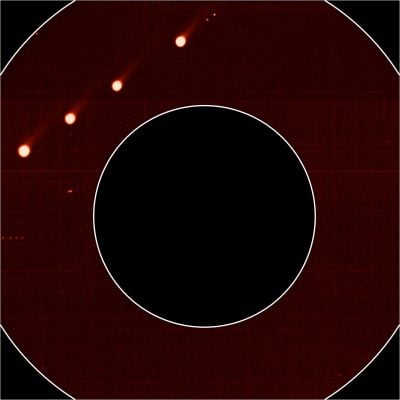
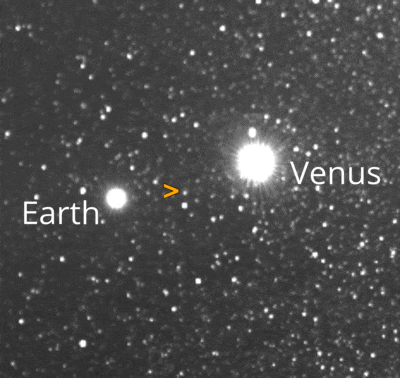
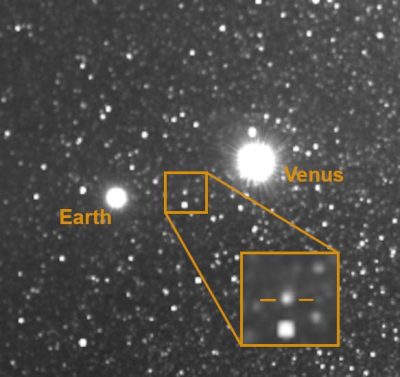
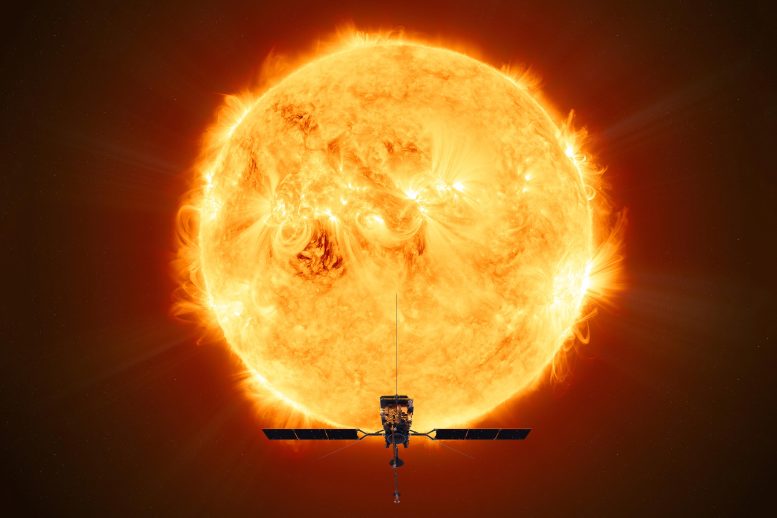






+ There are no comments
Add yours